Gluten Free Easy, Easy, Easy! French Bread Recipe
Updated Jun 09, 2025, Published Nov 11, 2011
This post contains affiliate links. Please see our disclosure policy.
Today is supposed to be a very lucky day – 11/11/11. And personally, I am inclined to believe it. It was lucky for me and I think lucky for you. I had a gluten free bread baking recipe breakthrough.
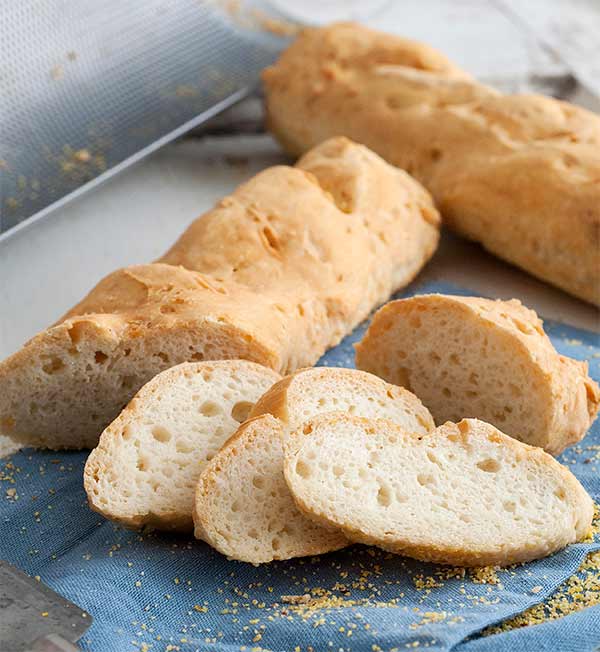
As a person who spends most of her time creating gluten free recipes you can imagine that I get my fair share of emails asking if I have a really good recipe for gluten free bread. Before going gluten free I made a few loaves of bread (with varying degrees of success) but I was by no means a bread baker. When I get these emails I think “Why ask me? Why not ask a bread baking expert?”
But the more I thought about it, the more I realized, I am probably the perfect person to ask. Why? Because:
1. I went for probably 15 years without eating bread so I know I can live without it – I would rather not eat bread than eat yucky, grainy, crumbly bread.
2. I love great food but I am also kind of lazy so I am always looking for the easiest way to make something.
3. I am not a person who finds it “relaxing” to knead dough by hand for 15 minutes. I wish I was that kind of person, but sadly when I do menial tasks for any period of time, my mind starts to wander and that is never a good thing!
4. I am success driven, persistent and some might even say a little OCD – I will keep at something until I get it right.
So, I decided to put my mind to making great gluten free breads. I decided to start with gluten free French Bread. I did my homework, I studied first the traditional French Bread recipes and methods, then I looked at gluten free ingredients and studied how to make them work better and finally, I baked and baked and baked!
I played around with flours and baking times and methods until I got a gluten free French Bread recipe that was crunchy on the outside, tender on the inside, beautifully browned, tastes like what French Bread should taste like and was easy to make. I threw away a lot of bread, enlisted everyone I came across (including a good number of whom are regular gluten-eaters) in blind taste testing and finally, I am pleased to say, came up with a recipe I am happy with! And I think YOU will love!
And you want to hear the very best thing? It is actually EASIER to make gluten free French Bread than it is to make the gluten-filled kind! Yes, you heard right – EASIER! No kneading, no double rising (I tried, better without) no hours until bread is ready. You can actually have lovely, perfect gluten free French Bread in about an hour and a half, start to finish!
Ok… so here are some tips I discovered:
Equipment
You are going to need a mixer – it is going to do pretty much all the work for you. You also need a French bread pan – gluten free bread needs support when it is rising and baking. Fortunately, you can get one for under $20.00 – considering the cost of decent gluten free bread, an investment so worth it! The pans come either perforated or solid, I used both in testing and it didn’t make a huge difference but I did like the results from the perforated pans slightly more. And finally, unless you are dead certain your oven is totally accurate, run over to the hardware or grocery store and grab an oven thermometer for about 4 bucks – you should have one anyway!
Kneading
Remember when the internet was all abuzz about no-knead bread? Ha! That’s old news to us gluten free bakers! 3 minutes in the mixer and that’s pretty much it, no kneading what-so-ever!
Yeast
I got the best result from Dry Active Yeast. It needs to be “active” so if you have had a jar sitting in your fridge since you can’t remember when, go get a new one – it lasts about 6 months refrigerated, after that it may not be good any longer. If you do store your yeast in the fridge then it will take longer for the yeast to “proof.” You want the yeast mixture to pretty much double in size and be all foamy.
Flours
After testing all sorts of different flour combinations, what worked best was a simple combo of white rice flour, sweet rice flour (also called glutinous flour) and tapioca starch. I used all Asian flours (Erawan Brand) which are more finely milled and cost a fraction of the flours you get in the health food store. I also tested this recipe using my own flour and it came out really great (well…dahaaa!) and the dough was a tad easier to work with.
Gum and Fat
I found that mixing the xanthan gum with the fat (olive oil) before adding it to the batter made it work better. I wish I could tell you why, just trust me on this.
Prep
Get all your ingredients out, mix your yeast, blend the xanthan gum with the oil and lightly beat your eggs before you start to mix, it makes it easier. Do the steps in order as I give you in the recipe.
The Dough
If you were used to bread making in a former pre-gluten-free life you will think there is not enough flour in the dough because it has a consistency more like a thick batter than dough. Resist with every fiber of your being from adding more flour! This is just the way gluten free bread dough is. You need to spoon the dough into the pans and shape it with a spatula – it won’t magically turn into pretty ovals unless you do this.
Slashing the Dough
Cutting 3 or 4 diagonal slashes into the top of the dough will help the steam escape while it is baking giving you a lovely, tender texture.
Prepping the Pans
Either spray your French Bread pans with gluten-free, non-stick cooking spray or brush with oil before putting the dough into the pans to rise. For a really authentic bottom, sprinkle a teaspoon of cornmeal on the bottom of the pans after you oil them up. It isn’t completely necessary but it does add that certain je ne se qua (fancy French term for “a certain something”). If using the perforated pans, place them on top of a baking sheet to oil and dust with cornmeal or you will have a mess to clean. Do not bake the bread on the baking sheet however, just put the French bread pan right on the oven rack.
Browning
I tested everything I could think of to get the perfect brown on the French Bread and what I found gave the best color came from brushing the loaves with melted butter just before baking. The good news is that they also came out beautifully browned with a brushing of melted Earth Balance as well – keeping the bread totally dairy free if need be.
Humidity
To get that crunchy crust and tender inside so characteristic of good French Bread it should bake in a humid environment. This is easily created by putting a pan of hot water into the oven while it preheats and just leaving it there while the bread is baking. You can also spritz the oven occasionally with water from a spray bottle but then you have to remember to do it whereas the pan of water just sits there and does its job.
Here’s how the whole thing goes:
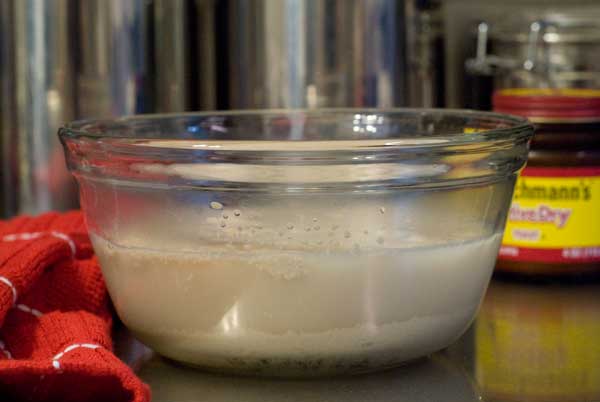
Mix the yeast, sugar and warm water – whisk to dissolve.
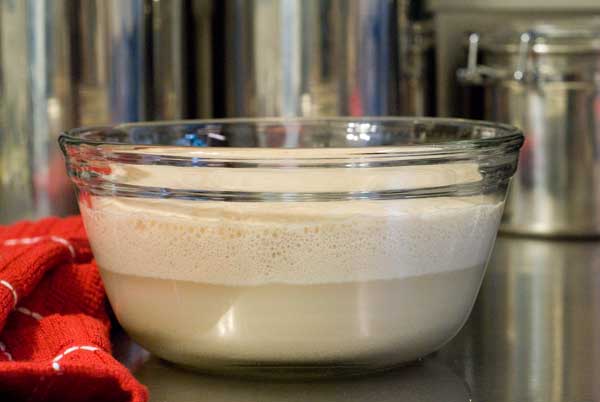
Let the yeast “proof” until foamy and doubled in volume.
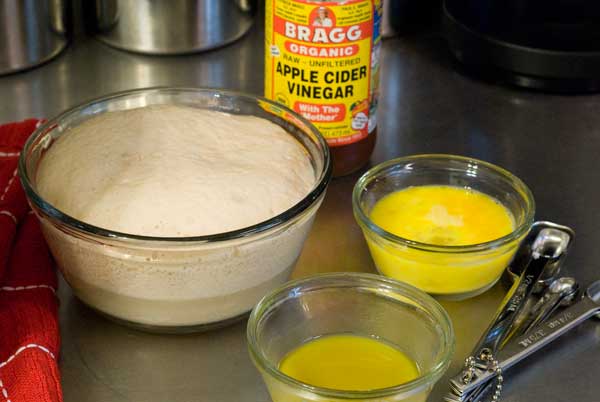
Get all your ingredients ready before mixing.
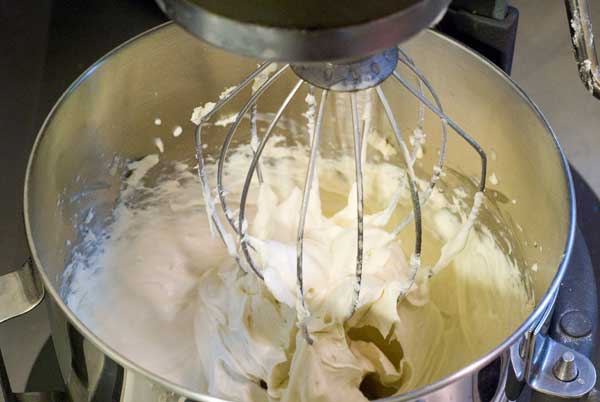
The dough will look more like batter than dough.
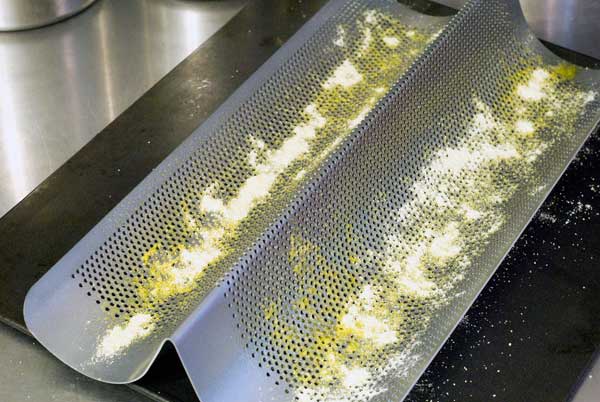
Grease the pan with oil and sprinkle with some cornmeal.
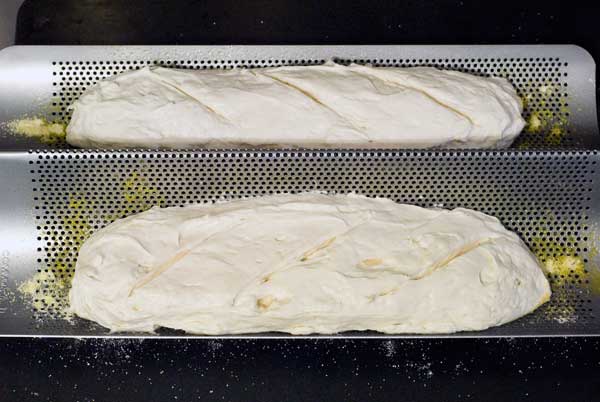
Spoon batter into pans, shape into ovals and slash the top 3 or 4 times.
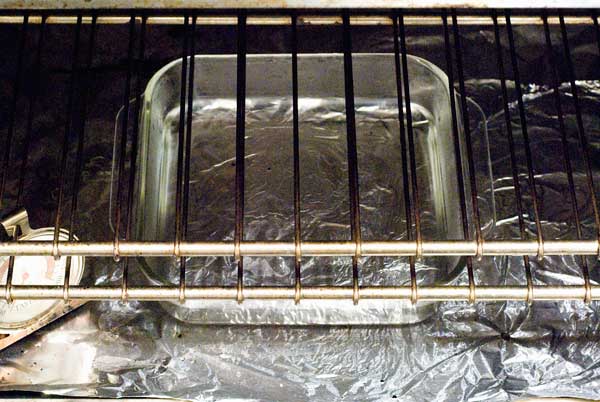
Place a pan of hot water into the bottom of oven.
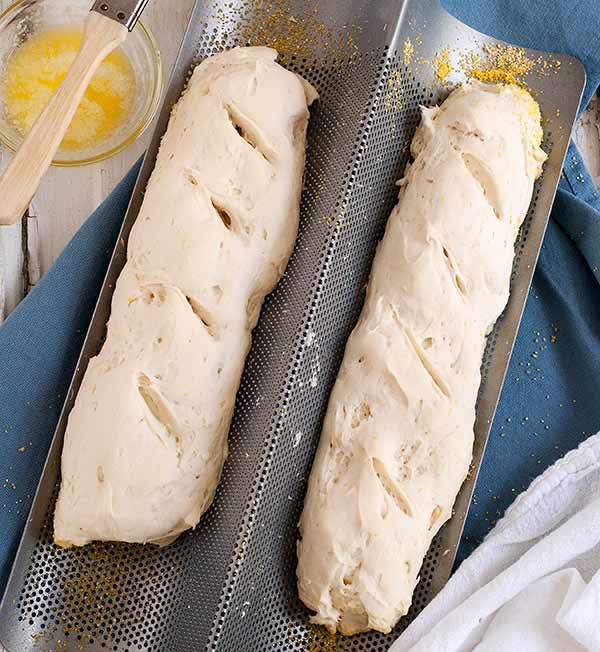


Gluten Free Easy, Easy, Easy! French Bread Recipe
Ingredients
- 2 tablespoons Dry Active Yeast
- 2 teaspoons sugar
- 1½ cups warm water, it should be pretty warm to the touch but not hot
- 3 teaspoons xanthan gum
- 2 tablespoons olive oil
- 1½ cups super fine or Asian white rice flour*
- ½ cup superfine or Asian sweet rice flour*
- 1 cup tapioca starch*
- 1½ teaspoons kosher or fine sea salt
- 2 large eggs, lightly beaten
- 1 teaspoon apple cider vinegar
- 2 teaspoons cornmeal, optional
- 2 tablespoons butter or Earth Balance, melted
Instructions
- Combine the yeast, sugar and warm water in a bowl about twice the size of the mixture and whisk to dissolve the sugar. Let sit for 5-6 minutes (10 if the yeast has been in the fridge) or until it is foamy and doubled in size.
- In a small bowl stir the xanthan gum with the olive oil until the xanthan gum is dissolved.
- Combine the flours, tapioca starch (or gluten free flour blend) and salt in the bowl of a mixer fitted with a whisk attachment (or just the regular beaters – don’t use a dough hook) and mix to combine. Add the yeast mixture, xanthan gum mixture, eggs and vinegar and mix on low to combine. Scrape down the sides of the bowl once. Turn the mixer to high and mix for 3 minutes.
- Spray a French bread pan (with 2 forms) with gluten-free, non-stick cooking spray or brush with more olive oil and sprinkle a teaspoon of cornmeal onto the bottom of each pan.
- Spoon the batter into the forms and shape into an oval with a spatula. Using a razor blade or sharp knife cut 3 or 4 diagonal slashes on top of each loaf. Cover the loaves with a clean kitchen towel and set in a warm, draft-free place to rise. Let rise for 30 minutes or until the loaves have doubled in size.
- Place a baking pan on the floor of your oven (or on the bottom shelf) and fill it with about an inch of really hot water. Position the rack you are baking the bread on in the middle of the oven. Turn the oven on and preheat to 400 degrees.
- Brush the top of the loaves with the melted butter or Earth Balance and bake for 40-45 minutes or until the loaves are golden brown and sound hollow when tapped. Let cool in the pan for 5 minutes then remove to a wire rack to finish cooling.
- You can also make crusty rolls by scooping the dough into 2 standard sized muffin tins, letting them rise 30 minutes and baking for about 20 minutes.
Notes
Nutrition
Nutrition information is automatically calculated, so should only be used as an approximation.
Shop This Post



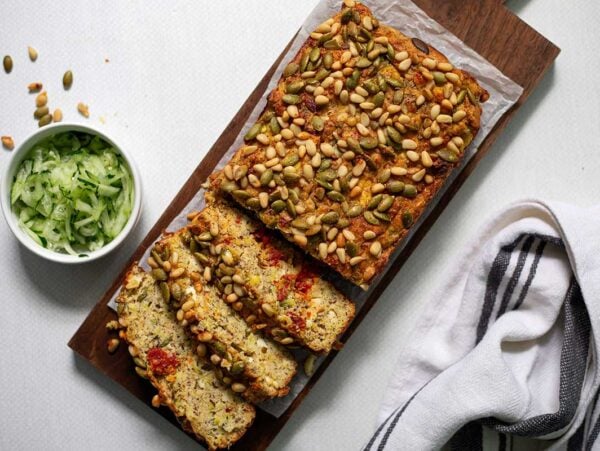











I want to try this french bread recipe but I cannot find the perforated french bread baking pan. Also, I cannot find any tapioca starch used in some of the recipes. Where might I find these?
Hi Joanne,
I got my bread pan from Bed Bath and Beyond and they also sell them on Amazon. As far as tapioca starch goes, you can google it and find on the internet or try the local health food store or Asian market. It is also sold on Amazon.
Good luck!
Thanks for another great recipe! For those who wondering about egg substitutes, the loaf came out really well. We use Orgran egg replacer, its convienient, cheap and lactose, gluten and egg (obviously =D) free. I would suggest adding an extra 1/4 cup of moisture though, but it might have something more to do with climate (we are in oz). Anyway my kids approve so thanks again!
My pleasure and thanks for the egg sub. Yes, humidity may play a role or the egg replacer may just require a bit more moisture but in any case thanks!!!
Carol, I made this bread today with your flour and it is absolutely wonderful !!!!! Will definitely be ordering more of your flour blend ! I’m also using it to make Amish Friendship Bread and my starter is in progress. I’ve also made a gluten starter to bake bread for our dau. and family and the gluten free starter with your flour blend, is doing just as well as the regular gluten starter. We can have the friendship bread again, thanks to your gluten free all purpose flour blend ! Thank you for all you do.
Oh, thank you so much Maryetta! Would love to know more about your Amish Friendship bread!
Carol, I made 2 loaves of gluten free Amish Friendship Bread for my husband and I and 2 loaves of the reg. (for our kids) and the gluten free ones with your all purpose flour blend, turned out beautifully, just as well as the regular ! We were so pleased ! It froze just as well as the regular, also ! Anyone who loves Amish Friendship Bread (sourdough sweet bread), and is gluten intolerant, should use your all purpose flour blend to make the starter and to make the bread with a starter on baking day. The only thing I changed from the recipe I used before having to go gluten free, was using your flour. It worked like a dream !!!! Thank you so much for your time and patience, in helping us to bake better on gluten free.
Thank you so much Maryetta. I am so happy the flour is working out for you and you are pleased!
Just made this bread for the third time. First two times into hotdog buns this time french bread. Family ate it as well today, they were pleasantly surprised and thought it was very good, thought it was softer than it looked on the crust. I really like it. (They are not gf)
Thanks for letting me know, I would never have thought to make these as hot dog buns but what a great idea! How did you form them? Do you have a special pan or did you just shape them onto baking sheets? You have my thoughts racing right now – I could make hoagie buns! DO you know how long its been since I had a really great gluten free submarine sandwich? Glad you family enjoyed them.
Can this be made with something other than rice flours? I am dairy/soy free, and was also told today from my naturopath to start avoiding wheat AND rice because they are affecting my adrenal glands & thyroid. Pretty soon I am going to have to live on air! :-)
Oh dear – I think it would work fine with other flours – can you use sorghum? I would try replacing the rice flour with that. I haven’t tried myself but I see no reason why it would not work. Let me know if you try it and your results!
I tried to make this tonight and the dough was way to liquidy. I don’t have a proper kitchen aid, just beaters–could this make a difference? The consistency was more like pancake batter than a tacky dough that can hold a shape like in the photo.
I think not using a stand mixer may be the difference. Off the top of my head I would say it needs to beat longer with a hand mixer. There is something about the beating that makes it work. I wish I understood the science better. My guess off the top of my head is that with regular beaters you would need to beat for something like 10 minutes – not fun but just think of something pleasant like George Clooney (or who ever you like) while doing it to pass the time.
Crusty rolls just came out of the oven. Excellent. Exactly what I needed to complete my GF gumbo tonight. Thanks.
My pleasure David! Thanks for reporting back!
I wanted to let you know I made this for the first time this morning (have to do something when kids get up at 4am!) and it is divine. It is THE BEST gluten free bread I have had – shop bought, scratch or packet made. Thankyou. I’m just about to do my second batch for the day for hamburgers tonight. Its been a year since my 6 year old son has had a hamburger! I now have a fabulous recipe to work with and add my own tweaks to.
So, I bought the pan and tried the bread. Everything looked good until it rose; throught the holes in the pan, over the sides, off the end. Made a giant mess. The only variation on the recipe was using guar gum for the xanthan since I am allergic to corn. Up to the rising stage it all looked like your pictures. I even use a Ktichen Aid stand mixer. What did I do wrong? I have made my own whole wheat bread for over 30 years with no problems. Cooking gluten free seems to be a major flop for me.
Hi Marni – I am wondering how warm your kitchen was – it sounds like it rose too much. I can not imagine that the guar gum would make a difference but I have never tried using it. This has me a little stumped, maybe if you can tell me more about the rising process I can help better.
Has anyone successfully made this bread with brown rice flour? I cannot get it to work. It seems that the brown rice flour soaks up much more liquid so becomes a very stiff dough but if I add more liquid, the baked result is a gummy mess inside a crust.
Hi Heather – I played around fr weeks with this recipe and found that the combination of flours I list in the recipe is what worked. Maybe someone else has had luck with converting the recipe to use brown rice flour.